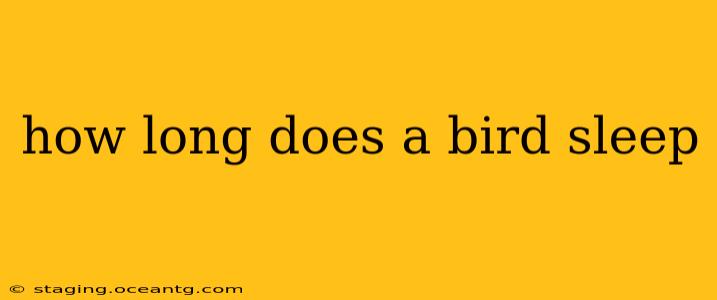How Long Does a Bird Sleep? A Deep Dive into Avian Slumber
Birds, those feathered wonders of the sky, lead surprisingly complex lives, and their sleep patterns are no exception. Unlike humans with a single, prolonged sleep period, avian sleep is a fascinating mix of short naps and longer, more restful periods, varying greatly depending on the species and their lifestyle. Understanding how long a bird sleeps requires looking beyond a simple number and exploring the nuances of their sleep architecture.
What are the different types of bird sleep?
Birds exhibit two distinct sleep states: Unihemispheric Slow-Wave Sleep (USWS) and Biphasic Slow-Wave Sleep (BSWS).
-
Unihemispheric Slow-Wave Sleep (USWS): This is a unique form of sleep where only one half of the bird's brain rests at a time. The other half remains alert, processing sensory information and monitoring the environment for potential threats. This is crucial for birds, especially those who are vulnerable to predators, enabling them to maintain vigilance while conserving energy. Think of wading birds, for example; one half of their brain remains awake while the other sleeps, allowing them to keep an eye on potential dangers while maintaining balance on one leg.
-
Biphasic Slow-Wave Sleep (BSWS): Similar to human sleep, this is when both hemispheres of the brain enter a state of slow-wave sleep. This deeper sleep is usually shorter in duration for birds and interspersed with periods of USWS.
How long do different types of birds sleep?
There's no single answer to "how long does a bird sleep?". Sleep duration varies drastically across species and their ecological niches.
-
Predatory birds: Often sleep for shorter periods, punctuated by frequent naps, due to their need for constant vigilance. Owls, for example, often sleep in short bursts throughout the day, adapting their sleep schedule to their nocturnal hunting patterns.
-
Small birds: Tend to sleep less than larger birds due to their higher metabolic rates and greater energy requirements. They often engage in frequent short naps throughout the day to conserve energy.
-
Large birds: Generally sleep longer than smaller birds but still utilize USWS extensively, particularly those who sleep in exposed locations.
-
Seabirds: Many seabirds adopt unique sleep strategies. They can achieve both USWS and BSWS while floating on water, making use of their natural buoyancy and ability to remain afloat even while partially asleep.
How long do birds sleep at night?
The length of nighttime sleep is again species-dependent, but generally, it's shorter than the total amount of sleep accumulated across the day and night. Even nocturnal birds require a blend of USWS and BSWS, ensuring both alertness and adequate rest.
Do birds dream?
While conclusive evidence remains elusive, scientists have found some evidence that birds might dream, suggesting that their sleep serves cognitive functions beyond simply physical restoration.
Do all birds sleep the same way?
No, the variety of avian sleep is vast. Factors influencing sleep duration and pattern include:
- Predation risk: Birds in high-risk environments tend to sleep less and more frequently.
- Environmental temperature: Birds may alter their sleep patterns in response to extreme temperatures.
- Social behavior: Sleep patterns can vary within and between social groups.
- Metabolic rate: Higher metabolic rates correlate with shorter sleep durations.
In Conclusion:
The question of how long a bird sleeps doesn’t have a simple answer. It's a complex interplay of species-specific traits, environmental pressures, and physiological needs. While there isn't a single number to represent all avian sleep duration, understanding the distinct types of bird sleep and the factors influencing it provides a more nuanced and complete picture of this fascinating aspect of avian biology.
